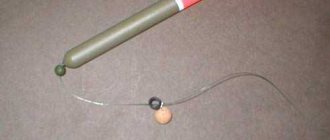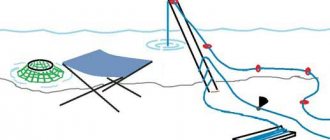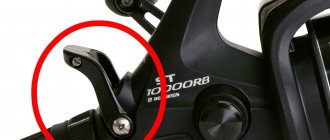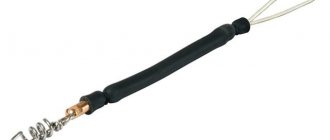A reel with the unusual name “multiplying” appeared as a result of a love for fishing and has become an integral and in demand among millions of anglers around the world.
The unusual history of the appearance of the reel, its design features, nature of application, differences from the inertialess reel, secrets of care - you will learn from this review.
A few words in favor of cartoonists
The design of multipliers is much simpler than that of inertialess reels, in which the number of elements can reach up to a hundred, as we wrote about in the article “How to use a multiplier reel for spinning and its principle of operation.” But even in this case, it requires quite careful handling and care. Do not allow it to get into water, but if this cannot be avoided, the reel must be opened and thoroughly cleaned.
- Quite often you can hear that you need to choose only an expensive reel, since cheap ones do not work well. In fact, this is not true, 80 percent of Americans use multis starting at $50.
- Fishermen are alarmed by the fact that after almost every fishing trip it is necessary to do maintenance. This is not true, the multiplier works perfectly throughout the entire fishing season, the exception is if it gurgles into the water.
- A lot of articles have been written about casting gear with a baitcaster, after reading which you begin to realize how difficult it is to cast with such a reel. In fact, everything is exactly the opposite. The main thing is to adjust the brake to the bait that will be used for fishing.
- A form for a multiplier can only be expensive. The statement is not entirely true; sensitivity is more determined by the reel and tactile transmission to the angler’s hand.
- The thread can be used of any cross-section, and this will not affect the range of the tackle.
- The fear of cartoons can be caused by another factor - the formation of beards. With sufficient skill, it is not difficult to avoid this, and unraveling the knot is often quite simple.
At fishing competitions, athletes prefer to work with multiplier reels that are capable of making long casts while accurately targeting the fishing spot. Modern cartoons are equipped with handles on both the left and right sides.
Adjusting the multiplier reel brakes
It often happens to an inexperienced fisherman that the cast fails and the line comes off more than necessary, the excess of which gets tangled and forms a beard. This is characterized by several factors:
- lack of bait casting skills or experience with another type of reel;
- incorrectly adjusted friction brakes of the multiplier;
- incorrectly selected equipment, for example, the cross-section of the line is larger than that indicated on the reel marking.
The first brake mechanism controls the rotation speed of the spool during casting. That is, the fisherman, sending the bait forward, causes the drum to rotate at a high speed, which can overtake the line. The inter-axial braking system stops the drum after splashing down the equipment, when the bait has already stopped and the spool is still rotating.
For successful fishing, it is enough to set the brakes once. The mechanical brake is set to half the force and then, during fishing, is adjusted more precisely depending on how the animator behaves. The magnetic brake is adjusted so that when the bait comes into contact with the pond, the drum makes one revolution.
This is interesting: Fishing bait reels
The beard problem
At shows and during speaking engagements, I am often asked about the beard problem when using a baitcasting reel.
I can say from my own experience that when fishing with a “multi”, if you use it correctly, you have to untangle the “beards” noticeably less often than with a spinning reel. And I reject the argument that with a multiplier you can only cast large and heavy baits. Modern Baitcaster-type baitcasting reels allow you to cast small, lightweight baits.
Now are you ready to give the baitcasting reel a chance?
But when going to the pond, keep in mind that the handling of spinning reels and baitcasting reels is somewhat different.
When switching from a spinning reel to a multiplier one, you will also have to change your casting technique. When casting with a “less spinning” bait, the bait is accelerated by a jerk of the hand.
If you use this technique when using a baitcasting reel, you will most likely have to untangle the beard first.
Casting with a multiplier should be carried out in a smooth motion, which will create ideal conditions for the line to come off when casting. Hold the rod in front of you.
The multiplier reel is mounted on it differently than the inertialess one, that is, on top. First press the lever or freewheel button, then immediately press your thumb against the spool. Otherwise, the line will begin to come off involuntarily.
Now make a swing, but the bait should not be accelerated sharply, otherwise you will get a “beard”. When the rod is at the 10:00 o'clock position when sending it forward, release the pressure of your thumb and release the line. And the bait will fly exactly to the place where you aimed.
Which fishing line to choose for a baitcasting reel video
You can watch the video “Fishing Investigations” with the Shcherbakov brothers online in good quality on our website which fishing line to choose for a multiplier reel for long-distance casting: fluorocarbon or braided fishing line. Enjoy watching!
Watch in this issue - the Shcherbakov brothers decided to check - which fishing line is better for long-distance casting? If you have a baitcasting reel, which line should you choose for long casting: braided or fluorocarbon?
Slowing down is important
While the bait is in flight, the casting is not yet completed. Before the bait lands on the water surface, the spool should be slightly braked with your thumb.
If this is not done, the line may “run over” and a “beard” may form. The bait dropped into the water, the line did not get tangled, but you are unhappy with the casting distance or accuracy.
In this case, I have a technique that will help ensure the necessary accuracy on crucial meters.
A line that is loose when swinging will not allow you to get the required casting distance. Therefore, before casting, the bait should hang 30–50 cm from the tip of the rod. Only in this case will the line always be taut during the swing.
The reason for an inaccurate and short cast may also be a thick, coarse fishing line. Because it doesn't come off the spool well.
When predominantly monofilament lines were used to catch predatory fish, this was a real problem. I had to use a fishing line of relatively large diameter. To extract large and strong fish from the water.
Today, most spinning anglers rely on braided fishing lines. Which, with a smaller diameter, have a high breaking load.
For heavy spinning fishing, a braided line with a diameter of 0.25–0.3 mm is suitable. For medium to light fishing I use 0.2mm braided line. And for ultra-lightweight, braided fishing line with a diameter of 0.12–0.15 mm is sufficient.
With such fishing lines you can make perfect casting.
What you need to know before casting a baitcasting reel
3
As we already wrote in the article “How casting rod tests affect equipment,” each spinning rod has its own calculated weight of baits, which are most effective to work with. If you deviate from these rules, the range will decrease significantly. In principle, the best bait is considered to be from the middle of the weight range.
So, if the test form is stated to be 10-30 g, then a 20-gram bait will be the most optimal. If you work with baits on the verge of a foul, the consequences can be unpleasant - from torn fishing line to a broken fishing rod. Lower weight ranges will also not bring anything good; the bait will simply flop under your feet.
The multiplier has resistance at the moment the tackle begins to be cast. The weight at the end of the line begins to spin the spool, overcoming the frictional force of various mechanisms. Having reached maximum speed, the drum begins to rotate by inertia. Don’t forget about the working timber distributor, which negatively affects casting.
This problem arises with the classic of multipliers - the wide bobbin drum. In a soap dish, casting is affected by the position of the line distributor relative to the spool, the most optimal being in the middle. Perhaps the range would increase if you used a blank for inertia-free action, but several factors interfere:
- scaffolding sagged;
- inappropriate system;
- uncharacteristic distribution of force on the form.
For meat grinders, similar characteristics are necessary, while the inertial force is compensated by the throwing power. In cartoons, the human factor plays a certain role. Thus, it is practically impossible to fine-tune both types of brakes; unnecessary braking will still be present.
To these two types of brakes, it is also necessary to add finger braking; as a result, a significant amount of much-needed energy is extinguished. There is an auto-tuning reel available for sale, but anglers are not very fond of it.
If you use a small-section line and a massive bait, a break can happen at any minute, so the tackle always needs to be properly adjusted. The weight of the bait should be in the middle of the test range. And there is no need to be afraid to use thick line; this will not affect the casting distance.
Casting with a baitcasting reel
When using a baitcasting reel, casting is done in a smooth motion. Casting using a strong hand jerk is not allowed, unlike fishing using a spinning reel. This is due to the likelihood of mixing up the line and giving the spool too much acceleration.
Multipliers allow you to use baits of almost any weight, from very light to massive and heavy. The rod is held straight in front of you. Before casting, press the lever and keep your thumb on the spool so that the line does not fall off. When swinging, you should not give excessive acceleration to the bait. When the rod is already 60° above the water surface, the finger pressure needs to be loosened to release the line.
Directly while casting with your thumb, you need to slow down a little to minimize the chance of a “beard” occurring. To increase the casting distance, you can lower the bait 35-40 cm from the top of the rod, thereby ensuring tension in the line.
When is a Bait Reel Required?
Even a novice fisherman can evaluate the pros and cons of a multiplier reel for a spinning rod. The complex design of a multi-reel for a spinning rod greatly affects prices, so low-priced models should be abandoned immediately. They will fail before they allow you to enjoy fishing.
This type of gear can be used for:
- trolling;
- casting from the shore;
- power fishing in a plumb line;
- fishing from a boat.
Multiplier reel
When choosing a baitcasting reel for a spinning rod, it is advisable to find a device with metal drive mechanism components. These last much longer.
This is interesting: Fly fishing reels
How to choose a baitcasting reel for spinning
Most anglers use spinning reels. The multiplier reel for spinning rods is undeservedly ignored. There is a common myth that fishing with a baitcaster requires more skill, and not everyone can master it. But in fact, a beginner needs to master the most ordinary casting, the same as when fishing with a spinning rod, which can be learned in a few times.
Multipliers are universal, they are used for many types of fishing with different weights of bait. They are effective for light baits from 3 to 20 grams, but they also work great with weights over 60 grams, unlike spinning baits.
Setting up the multiplier
To use a baitcasting reel for a spinning rod, you will need to spend time setting it up correctly. If a centrifugal brake is used, it is recommended to leave 1-2 weights to start with. This way the cast will be as far as possible without running the spool.
The main brake needs to be set as follows:
- Mount the reel on the rod.
- Hang the bait of the desired weight and size.
- Adjust the brake so that after a slight swing the bait drops 30-40 cm.
Setting up the multiplier
Thanks to this, casting will take place without tangling the line and running around.
It is important to follow the manufacturer's instructions when choosing the thickness of the gear. Otherwise, the increased load may damage the mechanism. It is not recommended to tighten the friction brake.
How to care for a cartoon
Before using a baitcasting reel for a spinning rod, you need to do some preparation. Typically, drive mechanisms are heavily lubricated for long-term storage. Therefore it is required:
- Unscrew the fasteners to remove the spool.
- Remove the element and find the bearings on it.
- Wipe their surface with a rag soaked in kerosene.
- Treat parts that come into contact during rotation in the same way.
- Remove excess lubricant from the brake system.
After fishing, spinning will also require attention. The worm gear should be cleaned of any sand and dirt that may have entered it so as not to cause excessive wear. They check for cleanliness and line laying.
Moving parts will need to be lubricated from time to time. It is advisable to choose branded formulations designed for this.
It is recommended to loosen the clutch after fishing - fluoroplastic plates have memory, and when tightened they gradually lose the necessary characteristics.
Using the Bait Reel
First of all, after purchase you need to get rid of excess grease, which, as a preservative, generously covers the inside of the reel. In a classic multiplier, you need to unscrew the protruding screws and remove the spool. The bearings will be exposed at its ends. They need to be wiped with a flannel moistened in kerosene. The ends of the spool itself and the places where it rotates must be subjected to the same operation. The “soap dish” additionally requires wiping the magnets. After this you can go fishing.
The same must be done after each return from fishing, with the additional responsibility of looking under the line guide. There you can see a worm gear that controls the winding of the fishing line. There may be sand in it. This cannot be allowed. Without completely disassembling the line guide, you need to clean the gear with the same cloth and lubricate it again. For lubrication, it is better to use branded products. In the absence of such, you can use technical Vaseline.
There is another important detail in the multiplier - the friction clutch, consisting of a series of gaskets. They are made of metal and fluoroplastic. In order for the fluoroplastic to remain elastic, the clutch must be loosened during storage. And put it back into working condition only for the duration of fishing.
If you don’t shy away from maintenance, the coil will delight you with its performance for a long time.
Pros and cons of the multiplier
Advantages:
- long casting range (with heavy baits);
- withstands extreme loads (fishing in “Big Game” competitions, hard wiring of bait, for example, a jerkbait);
- direct contact with the bait;
- the line layer is ideal for “braid”;
- durability.
Flaws:
- problems arising with light baits (up to 10 g);
- casting requires practice;
- line dash;
- as a rule, an unusual operating mode for the right hand.
Pros and cons of a spinning reel
Advantages:
- also suitable for throwing light baits;
- Delicate fishing with an open bow is possible;
- ease of maintenance;
- a “beard” rarely forms;
- a large assortment
Flaws:
- problems arising under extreme loads;
- not too durable;
- does not perform ultra-long casts;
- on popular models, the laying of braided fishing line is often not careful enough.
Views: 426
Advantages and disadvantages of a multiplier reel
The pros and cons of a multiplier reel for spinning rods are worth considering in detail.
Pros:
- greater sensitivity to bites;
- casting range does not depend on the choice of fishing line thickness;
- The weight of the set is small - no more than 300 g;
- low landing of the rings, close location of the spool to the blank;
- thanks to the design, the line does not twist;
- suitable for fishing with wobblers;
- allows you to use baits of different weights.
Advantages and disadvantages of a multiplier reel
Minuses:
- you will have to first master the casting technique;
- winding onto the spool is slower than when using a spinning reel;
- you will need to adjust the brakes;
- the cost is quite high;
- using ultralight bait is not always effective;
- not suitable for fishing in winter.
The main advantage of multipliers is the ability to use impressive bait and high casting accuracy.
Advantages and disadvantages
Advantages of a baitcasting reel
- The design of the multiplier reel allows you to fish with much larger baits that require jerking than with spinning reels of approximately the same class. With a small multiplier that fits in the palm of your hand, you can confidently “work” with jerkbaits up to 60 grams. A spinning reel with similar characteristics is much larger in size and weight.
- A multiplier reel, thanks to direct transmission (in the gearbox, the axis of the input shaft is parallel to the axis of the output shaft), will easily allow you to “pump out” large fish, which can easily deal with the springs or gear teeth of your spinning reel. A small “cartoon” can easily cope with a weight of about 60 kilograms. After all, in fact, you have a micro winch in your hands.
- The multiplier works on the principle of an inertial reel and does not twist the line at all. In 100% spinning reels this problem is not completely solved. Roller designs only reduce this effect.
- Due to the fact that the baitcasting reel is located on top of the rod, the tackle is much more sensitive to any, even the weakest bite.
- The world record for casting distance using a baitcasting reel in 1994 was 278 meters (using a weight weighing 12 grams). Using any spinning reel, you will never cast that kind of weight even half the specified distance. In addition, casting long distances using a multicast requires less effort.
- When using a baitcasting reel, the casting distance does not depend significantly on the thickness of the fishing line.
- 80% of US professional fishermen use baitcasting reels. They are the main reels of spinning sports.
Disadvantages of a baitcasting reel
- The price of a high-quality baitcasting reel is significantly higher than that of a spinning reel.
- Learning to use a spinning reel is easier than learning to use a multiplier. It takes some time to master the skills of working with it.
- After casting, the rod equipped with a multiplier should be transferred from the right hand to the left each time. However, there are examples with a left handle.
- A fishing rod equipped with a baitcasting reel is harder to hold in your hand, since it is located on top.
- The baitcasting reel is more difficult to set up. It is necessary to adjust the braking system in accordance with the weight of the bait.











